We are excited that a good friend of ours is coming to visit in April, and we are starting to think about our route south in June. I know it's still a few months out, but we do have a whole continent to consider...
Tuesday, March 13, 2012
Suriname update - last one for now
It's time for us to take another break from our blog updates, and get back to our Tutu routine. In the meantime, Jill will be keeping the kids in line:
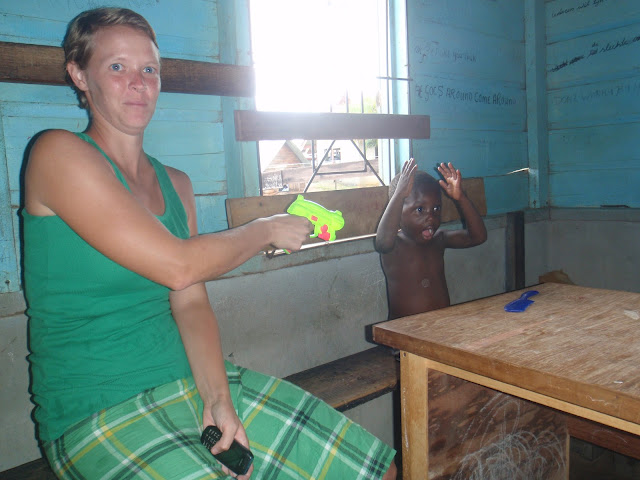
We are excited that a good friend of ours is coming to visit in April, and we are starting to think about our route south in June. I know it's still a few months out, but we do have a whole continent to consider...
We are excited that a good friend of ours is coming to visit in April, and we are starting to think about our route south in June. I know it's still a few months out, but we do have a whole continent to consider...
Justapositions
Suriname is full of juxtapositions - things sitting side by side that just don't seem like they belong that way. Some examples are brilliant, and a source of pride for Surinamese, such as the mosque and synagogue side by side (that you may remember from our Guided Paramaribo Tour post):
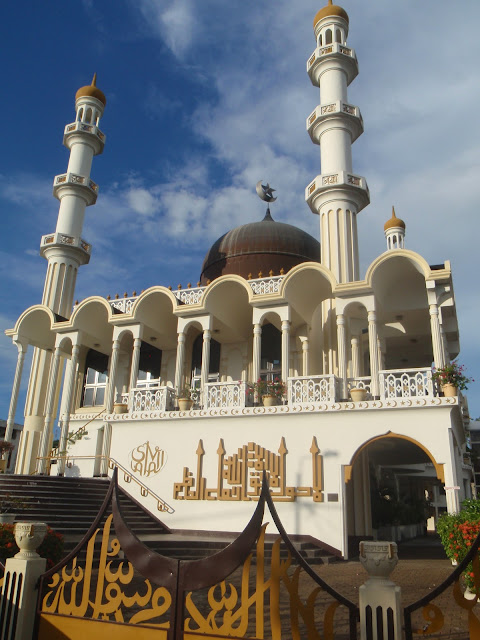
(mosque)

(synagogue)
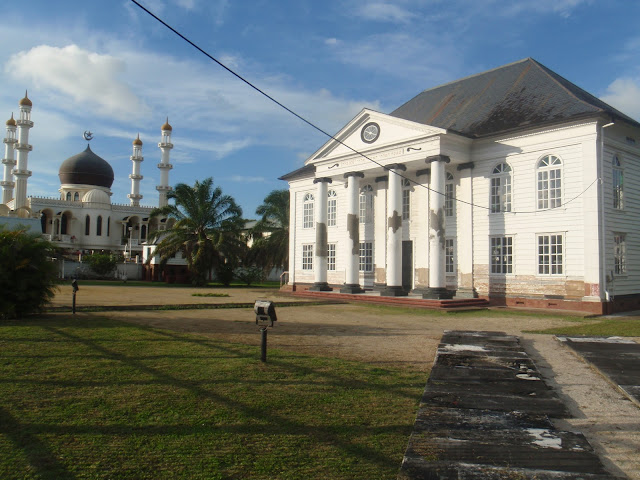
(Juxtaposed! well, maybe just a really rare sight, not truly a juxtaposition, but close enough...)
Another perfectly Saramaccan example of juxtaposition comes from the culture of carrying song birds, especially common in Paramaribo. The best examples are the biggest, toughest, dreaded-out, muscle-bound guys holding a cage with a tiny hummingbird in it. One of these days we will ask to get a picture of a good example, but for now, I am sorry that you are stuck with a placeholder.

(Mike finds the contrast between huge, tough looking dudes and their tiny, singing birds hysterical, but has so far been too chicken to get a picture)
Other juxtapositions are found in passing.

(granted, these 2 products are both mechanical, so kinda fit together...kinda)
But so far, the blue ribbon goes to:

(huh?)
(mosque)
(synagogue)
(Juxtaposed! well, maybe just a really rare sight, not truly a juxtaposition, but close enough...)
Another perfectly Saramaccan example of juxtaposition comes from the culture of carrying song birds, especially common in Paramaribo. The best examples are the biggest, toughest, dreaded-out, muscle-bound guys holding a cage with a tiny hummingbird in it. One of these days we will ask to get a picture of a good example, but for now, I am sorry that you are stuck with a placeholder.
(Mike finds the contrast between huge, tough looking dudes and their tiny, singing birds hysterical, but has so far been too chicken to get a picture)
Other juxtapositions are found in passing.

(granted, these 2 products are both mechanical, so kinda fit together...kinda)
But so far, the blue ribbon goes to:

(huh?)
Further Upper Suriname
Both Jill and I were able to travel with BFN up the Upper Suriname to talk with some other villages about current and potential collaborations.
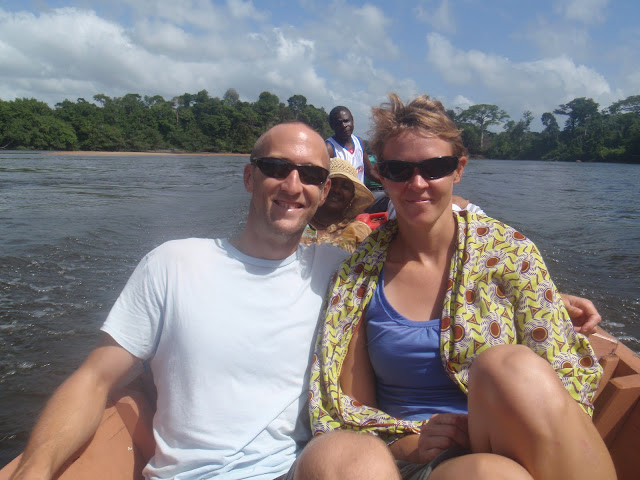

(cell phone coverage is everywhere along the river)

(the water was high enough to not portage, but some extra steering helped)
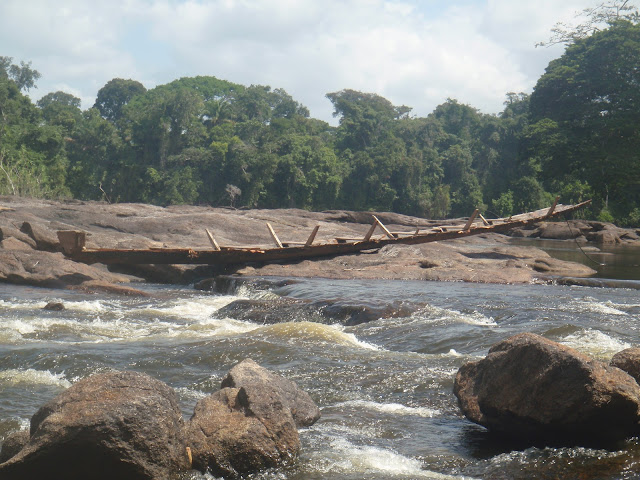
(they shoulda portaged)

(notched log ladders)
Arriving at Pikin Slee, we saw dugout canoes in progress. Boatmaking is done by a select few men who get paid fairly well for their work. Well built dugouts will easily run more than 5000 SRD. That covers all steps of fabrication, from selecting a tree to felling it and bringing it back to the village (that's got to be the bulk of the labor right there) then removing bark, hollowing out, and burning the tree before building up the sides.

(hollowed out)
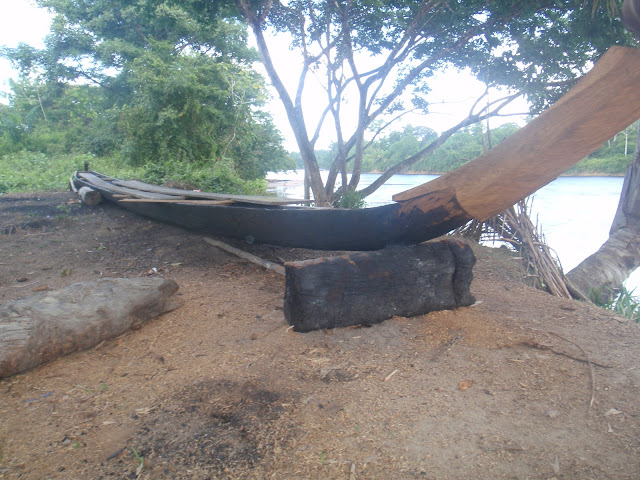
(another example post burning)
A Saramaccan Museum exists in Pikin Slee, requiring a 10-15 minute walk back through the large village to the museum. The path is identified by sculptures like these along the way:
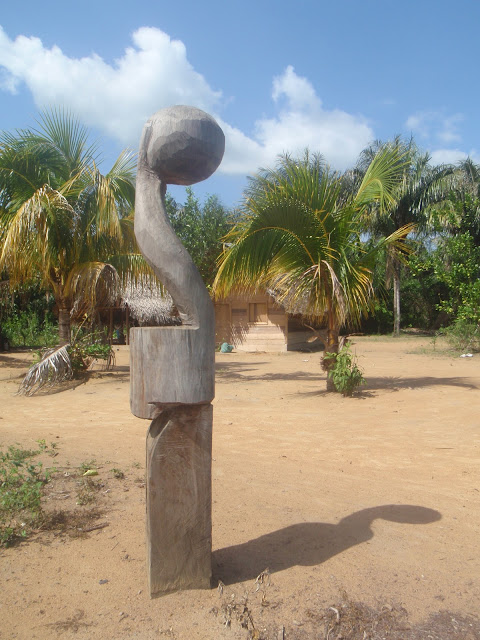
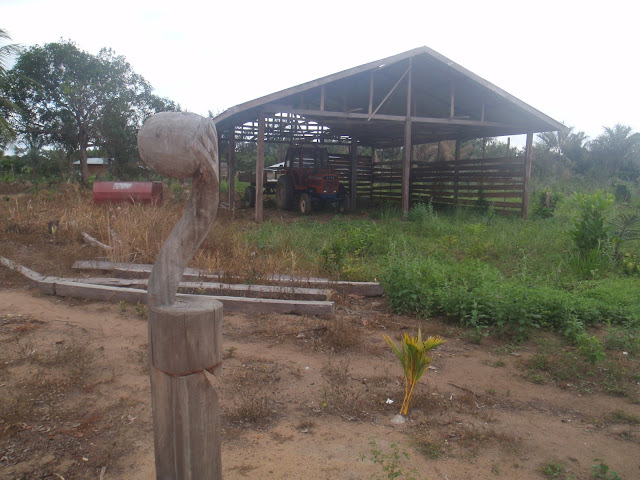
(notice the tractor in the background? That was brought to Pikin Slee along the Upper Suriname river, likely using 2 canoes running parallel, catamaran style.)
The museum was established by Saramaccans without support from Foto NGO's, which is a pretty sweet grass roots success showing a lot of forward thinking regarding tourism.


(this dugout canoe got repurposed)

(a carving in progress)
On the way back to Tutu, we stopped in a couple of other villages to discuss possibility of BFN working with the village in the future.

(Bai, Mike, and Chifarro walking through Guyaba)

(Guyaba, but a good example of a village scene anywhere along the Upper Suriname)
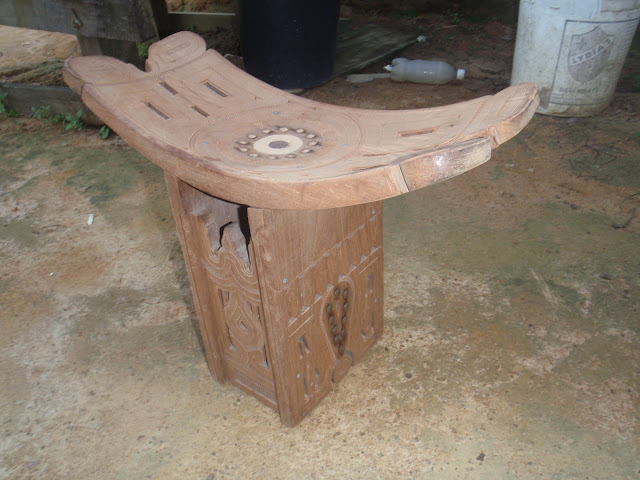
(a nicely decorated bangi, or seat, made in Guyaba. The curved seat section implies it's a woman's seat. A flat seat is for men. I'm not sure either one really wins on comfort)
Some living souvenirs took the trip back to Foto with the BFN staff:

(Marciano with his new pet turtle)

(Rashida with her new pet...and distant dinner)
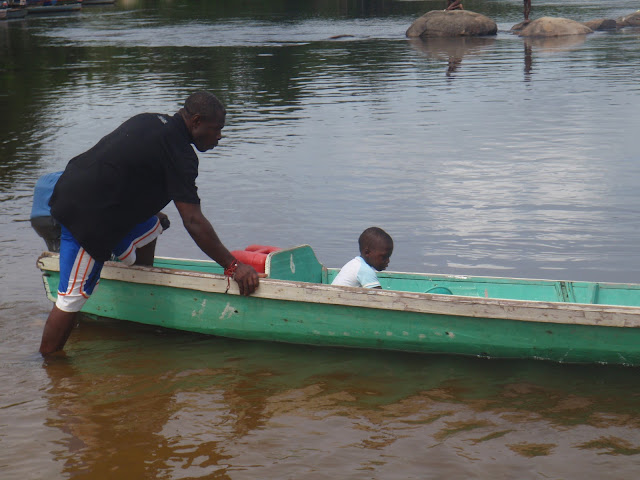
(Chifarro bailing as Bai pushes off)
(cell phone coverage is everywhere along the river)

(the water was high enough to not portage, but some extra steering helped)
(they shoulda portaged)
(notched log ladders)
Arriving at Pikin Slee, we saw dugout canoes in progress. Boatmaking is done by a select few men who get paid fairly well for their work. Well built dugouts will easily run more than 5000 SRD. That covers all steps of fabrication, from selecting a tree to felling it and bringing it back to the village (that's got to be the bulk of the labor right there) then removing bark, hollowing out, and burning the tree before building up the sides.

(hollowed out)
(another example post burning)
A Saramaccan Museum exists in Pikin Slee, requiring a 10-15 minute walk back through the large village to the museum. The path is identified by sculptures like these along the way:
(notice the tractor in the background? That was brought to Pikin Slee along the Upper Suriname river, likely using 2 canoes running parallel, catamaran style.)
The museum was established by Saramaccans without support from Foto NGO's, which is a pretty sweet grass roots success showing a lot of forward thinking regarding tourism.
(this dugout canoe got repurposed)

(a carving in progress)
On the way back to Tutu, we stopped in a couple of other villages to discuss possibility of BFN working with the village in the future.

(Bai, Mike, and Chifarro walking through Guyaba)

(Guyaba, but a good example of a village scene anywhere along the Upper Suriname)
(a nicely decorated bangi, or seat, made in Guyaba. The curved seat section implies it's a woman's seat. A flat seat is for men. I'm not sure either one really wins on comfort)
Some living souvenirs took the trip back to Foto with the BFN staff:
(Marciano with his new pet turtle)
(Rashida with her new pet...and distant dinner)
(Chifarro bailing as Bai pushes off)
Workin Life
Jill's counterpart Bai and his wife Rosita are absolutely wonderful. They have helped out in so many ways, from helping Jill get moved from Foto to Tutu, to offering up their daughter's house for us to live in (she lives in Foto now), and making sure we get to try some of Rosie's amazing cooking evey once in awhile.

(Jill with Bai, her counterpart)
On the days that tourists come to town, at least 2 women (and usually Jill) go to the shop around 9:30 to get it set up. They end up spending all morning there waiting for the tourists to arrive, whose schedule is less than defined. Even though that takes a big chunk out of the women's day, it does provide a chance for a few of the women to meet informally, work on their crafts, gossip, talk about group related issues, etc. At least the time isn't entirely wasted.

(Inside the shop with Magaly and Resida on duty. All money from sales go to the woman who made the product sold, with a small amount put into group savings for the coop)

(another view)

(Magaly tracing a pattern for another kousu)
Every two weeks, Jill has been meeting with the group as a whole. Those meetings provide a better chance to discuss and resolve issues as a group, including sales, inventory, and future planning. One of the first tasks that Jill has been trying to coordinate between the women's group and BFN is to get tags printed to attach to each piece of merchandise. The women were intially relying on pieces of paper that could easily get detached, leading to confusion when that item was purchased. It was great to see that those pieces of paper were already in use, that way Jill's suggestion to use a standard, more presentable tag is just a slight improvement on what they already do. The new tags will have the cost as well as a bit of information about the women's group on them and the name of the woman who made that item. It has taken some time to get the printing job approved, but hopefully the next time we are in the city we will be able to take back a stack of tags.
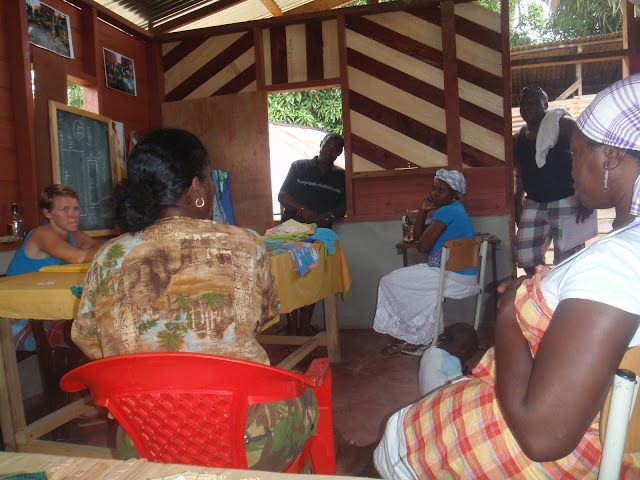
(A meeting of the coop at the shop with Jill, Rashida (back), Bai, Magaly, Marciano, Moetoe, and others not pictured)
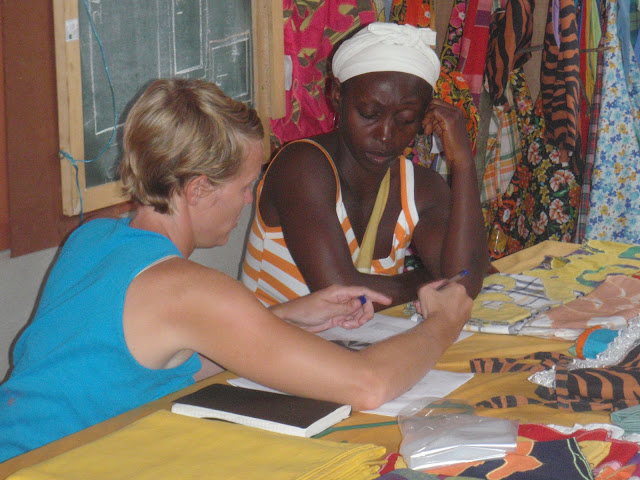
(Jill going over December sales with Clea)

(Jill with Bai, her counterpart)
On the days that tourists come to town, at least 2 women (and usually Jill) go to the shop around 9:30 to get it set up. They end up spending all morning there waiting for the tourists to arrive, whose schedule is less than defined. Even though that takes a big chunk out of the women's day, it does provide a chance for a few of the women to meet informally, work on their crafts, gossip, talk about group related issues, etc. At least the time isn't entirely wasted.
(Inside the shop with Magaly and Resida on duty. All money from sales go to the woman who made the product sold, with a small amount put into group savings for the coop)
(another view)

(Magaly tracing a pattern for another kousu)
Every two weeks, Jill has been meeting with the group as a whole. Those meetings provide a better chance to discuss and resolve issues as a group, including sales, inventory, and future planning. One of the first tasks that Jill has been trying to coordinate between the women's group and BFN is to get tags printed to attach to each piece of merchandise. The women were intially relying on pieces of paper that could easily get detached, leading to confusion when that item was purchased. It was great to see that those pieces of paper were already in use, that way Jill's suggestion to use a standard, more presentable tag is just a slight improvement on what they already do. The new tags will have the cost as well as a bit of information about the women's group on them and the name of the woman who made that item. It has taken some time to get the printing job approved, but hopefully the next time we are in the city we will be able to take back a stack of tags.
(A meeting of the coop at the shop with Jill, Rashida (back), Bai, Magaly, Marciano, Moetoe, and others not pictured)
(Jill going over December sales with Clea)
Insight into the Industry
Back in early December 2011, when we had just arrived in Suriname, many PC volunteers brought crafts made in their communites into Foto for a cultural event put on by the Ambassador's wives club. It was a really good opportunity for Jill (and Mike, too) to see what types of products were being made, how much they were being sold for, and to talk with the volunteers more specifically about their role in all of it.

(the event was really well attended)
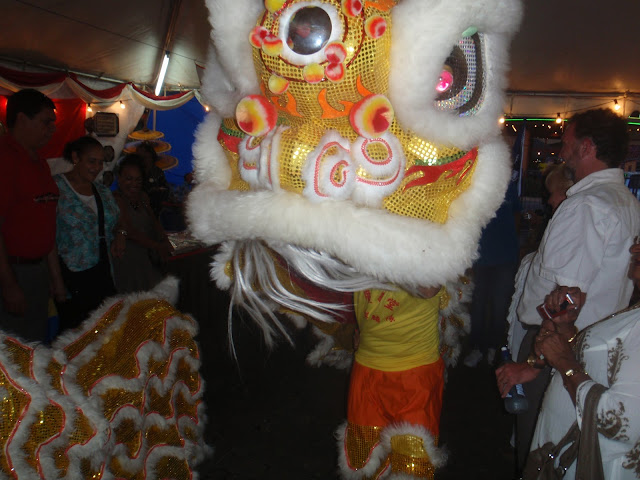
(and showcased everything from exotic dragon dances...)

(...to Canadians drinking beer.)

(some of the crafts brought in by Peace Corps volunteers)

(Jill picking up some handcraft insight)
We also had the chance to attend a store opening in Bakaaboto, a tourist destination, but mostly for domestic tourists (usually from Paramaribo who have disposable income). This store opening was made possible by BFN, the organization Jill is working with, and is similar in some regards to the store that Jill helps out with in Tutubuka.
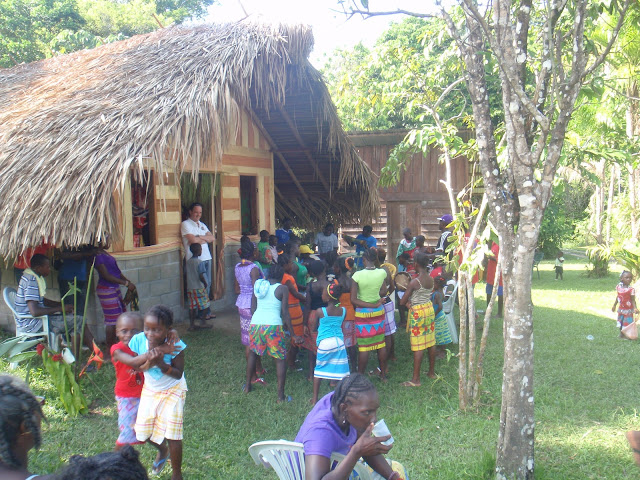
(the newly constructed shop at Bakaaboto)

(Bakaaboto put on a show for the store opening, with a drumming, dancing, and lots of good food)

(all this before the grand opening lecture....errr...I mean, speech. Note that the speech was given in Sranan Tango, which is a different language then Saramaccan. This was one of Mike's first glimpses of the large divide that exists between the Surinamese and the Saramaccans)

(this lady knew how to get through it)
The store opening was interesting to see, but a bit difficult to see the interaction between the city dwellers and the Saramaccans. It was more fun to see the shop in operation when we had a chance to return to Bakaaboto a couple of months later. It was still well-stocked, had a very nice display of the products, and they save a portion of the sales into a group savings fund. They are doing great so far!
(the event was really well attended)
(and showcased everything from exotic dragon dances...)

(...to Canadians drinking beer.)

(some of the crafts brought in by Peace Corps volunteers)
(Jill picking up some handcraft insight)
We also had the chance to attend a store opening in Bakaaboto, a tourist destination, but mostly for domestic tourists (usually from Paramaribo who have disposable income). This store opening was made possible by BFN, the organization Jill is working with, and is similar in some regards to the store that Jill helps out with in Tutubuka.
(the newly constructed shop at Bakaaboto)

(Bakaaboto put on a show for the store opening, with a drumming, dancing, and lots of good food)

(all this before the grand opening lecture....errr...I mean, speech. Note that the speech was given in Sranan Tango, which is a different language then Saramaccan. This was one of Mike's first glimpses of the large divide that exists between the Surinamese and the Saramaccans)
(this lady knew how to get through it)
The store opening was interesting to see, but a bit difficult to see the interaction between the city dwellers and the Saramaccans. It was more fun to see the shop in operation when we had a chance to return to Bakaaboto a couple of months later. It was still well-stocked, had a very nice display of the products, and they save a portion of the sales into a group savings fund. They are doing great so far!
Suriname update - another of many
Random events in Tutu keep the days moving along. For instance, Josh, a Peace Corps volunteer who has been in Tutu for almost 2 years, needed a new roof on his gangasa, or cookhouse. Helping out/watching provided almost a full day of entertainment.
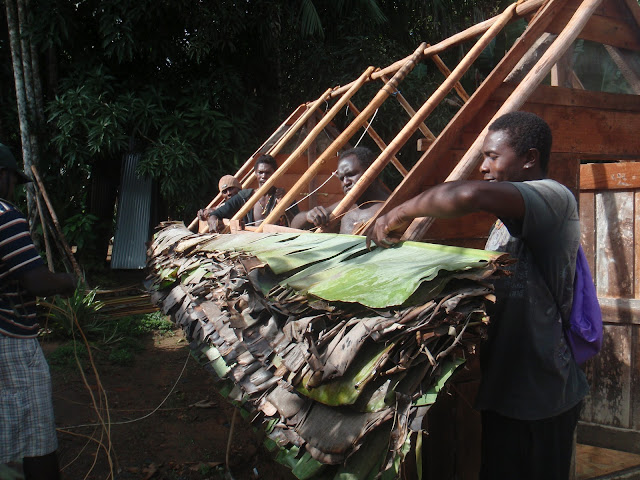
(roof work party lashing dried, folded leaves in place)

(These guys showed up prepared with a boombox, some fried dough, and a couple of j's (I guess you gotta entertain yourself somehow if you are tying leaves all day long))
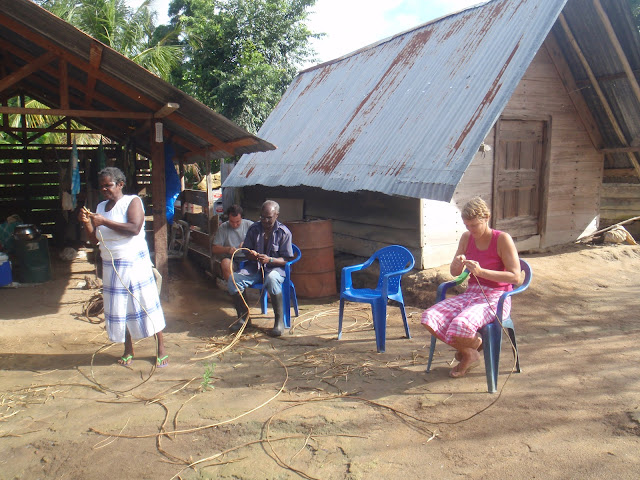
(Our job was an easy one since they had already collected all of these vines and had them soaking. We helped peel the bark off the entire length of each vine (~5m))

(Edwin preparing vines for lashing by splitting it into 4 or 5 individual strands)

(One side of the roof nearing completion. The final cap on the roof is placed with a different type of leaf, but no final picture. You'll just have to believe me for now)
Other highlights come for us when we get to go into the big city every month or so. One of our favorite evenings was when we met up with some of our friends for a sweet dinner in Foto!

(Mike, Cabrini, Cameron, and Deb enjoying some pie and wine in Foto)
To provide you with some of the randomness that keeps us going:
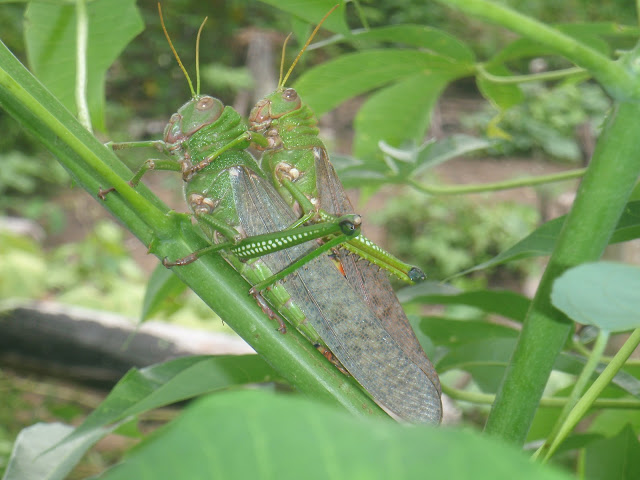
(These grasshoppers have nothing to do with anything. But they provided a good break in the day.)
Grasshoppers are much more pleasant to come across than gross tube worm thingies that put worms in your foot if you step on them.

While on random animal pictures, these fuzzy creatures (below) are everywhere, often where you'd least expect them. At least they only make you itch if you touch 'em

(roof work party lashing dried, folded leaves in place)
(These guys showed up prepared with a boombox, some fried dough, and a couple of j's (I guess you gotta entertain yourself somehow if you are tying leaves all day long))
(Our job was an easy one since they had already collected all of these vines and had them soaking. We helped peel the bark off the entire length of each vine (~5m))
(Edwin preparing vines for lashing by splitting it into 4 or 5 individual strands)

(One side of the roof nearing completion. The final cap on the roof is placed with a different type of leaf, but no final picture. You'll just have to believe me for now)
Other highlights come for us when we get to go into the big city every month or so. One of our favorite evenings was when we met up with some of our friends for a sweet dinner in Foto!
(Mike, Cabrini, Cameron, and Deb enjoying some pie and wine in Foto)
To provide you with some of the randomness that keeps us going:
(These grasshoppers have nothing to do with anything. But they provided a good break in the day.)
Grasshoppers are much more pleasant to come across than gross tube worm thingies that put worms in your foot if you step on them.
While on random animal pictures, these fuzzy creatures (below) are everywhere, often where you'd least expect them. At least they only make you itch if you touch 'em
Friday, March 9, 2012
Holidays in Tutu
Tutubuka is considered to be a Christian village. Church is attended frequently, especially around funerals and holidays. Sadly, funerals in Tutu are much more common than holidays.
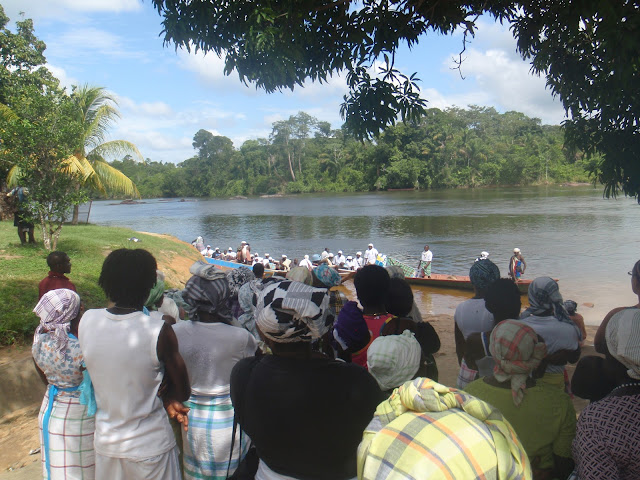
(funeral procession of men close to the deceased going to burial ground downriver. This is after days of mourning, staying up all night each night, and some ceremonies. The eighth day after death is also recognized, as well as 6 weeks after. Funerals and grieving are especially important to all community members, often due to close family ties.)
Holidays are also recognized by the entire community. Often by attending church for a very long time. We're talking hours on end.

(this is the entry to the church in Tutu)
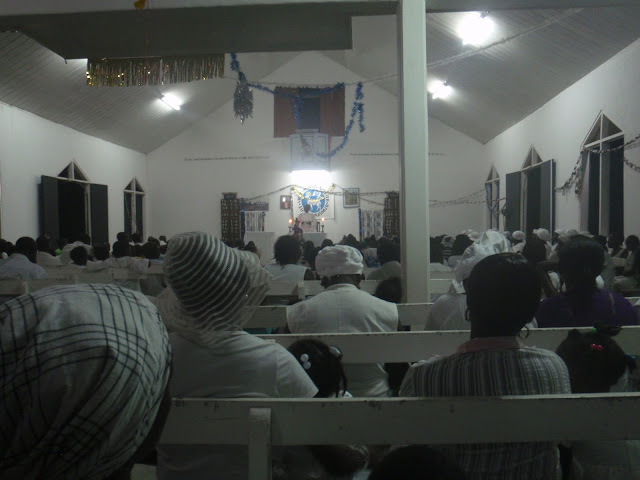
(Christmas service with everyone in their finest whites)
But most holiday traditions take place as part of the daily routine. Just like the "odi", or greetings, that people must exchange in passing, "Bedake" (= Merry Christmas) is said to all, even those people that are partially hidden in a house, around a corner, not paying attention to you...literally all people...to a comical extent at times. The best part about the Bedake exchange is the delivery - you gotta say it to the other person faster and more times than they can deliver to you. Often people get out a solid 3 or 4 Bedakes before they realize that you are also saying Bedake and that their message has made it through. It's much more fun than the comparatively solemn "Merry Christmas" exchange that we are so used to.
Saramaccan women love to cook. One of their specialties is cassava bread made from bitter cassava. Interestingly, cassava roots contain cyanide, so must be prepared properly. After pulling them up, they are roughly chopped, then ground/grated into small pieces. Next they are all placed into a long, thin basket
(metape) to allow all of the cyanide-containing water to drain out:

Once the dried cassava is ready, it is poured onto a flat hot plate to cook on a wood fire:

Each women has her own designs that she traces into the bread:

There is plenty of cassava bread to go around during the holidays. Plenty. More than enough. That stuff is sooo dry, kind of bland with a hint of bitterness, and will make your stomach hurt real bad if you eat too much of it (mmmmmm....cyanide...). But they love it.
Between Christmas and New Year's there was a traveling group of singing children, as well as a traveling drum circle.

New Year's also includes festive odi exchanges for yai, or "year". Customary is a long duration handshake with multiple yai's between two people, and the yai's continue as the handshake is brought up above head height, then unlocked with a final yai-ooooo yai, followed by much smiling and laughter.
Around the 1st, people generally wash with a particular type of leaf purported to cleanse the last year from you and bring good luck for the new year.

On the 1st, everyone dresses in their New Year's finest.

(Jan 1st, 2012 - Jill in her kousu and hangisa, wrapped around the waist as a sign that she has a man. The women in Tutu were insistent that Jill wear one, especially with all the out of towners in Tutu for the holidays. They're looking out. Mike was lent this traditionally cross stitched banjakoto for the day. It was somehow still that white when he returned it)
Much of NYE we spent at our place with toasts of Borgoe rum, and the traditional lizard dropping from the ceiling (analogous to the old fashioned ball drop). The village was relatively sleepy until midnight (in fact, most were at church since 8 in the evening...), but at midnight, a container's worth of fireworks were going off in all directions. Kids were mostly in charge of the mayhem, and absolutely loving it.

(this lizard did not drop from the ceiling on New Years. This one's just really ugly)
The real parties picked up on the 1st (much more so than the night of the 31st) and continued through the whole month of January. That's a fun tradition - to extend the celebration. At a "tapa yai" (= end the new year party's) party on the last few days of January live bands played in the town hall with most of Tutu/Tjai in attendance. An all night shindig. Not a bad way to bring in 2012, no matter what the date.
Some people tended to get more than just a buzz on during the holidays. And sometimes they just need a hug.
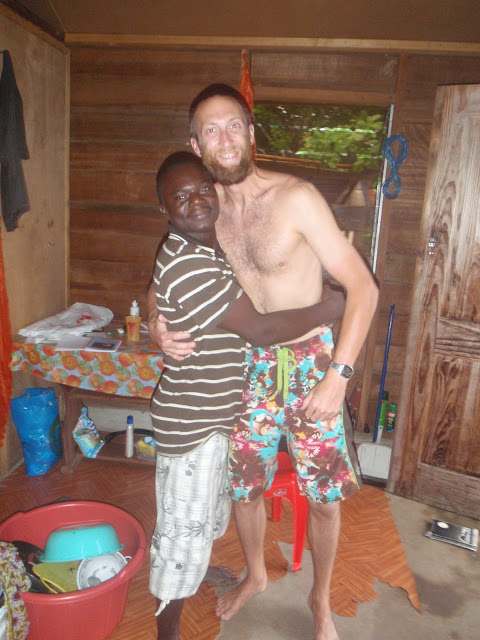
(you never know until the shutter releases what type of pose a Saramaccan has in mind for a picture)
(funeral procession of men close to the deceased going to burial ground downriver. This is after days of mourning, staying up all night each night, and some ceremonies. The eighth day after death is also recognized, as well as 6 weeks after. Funerals and grieving are especially important to all community members, often due to close family ties.)
Holidays are also recognized by the entire community. Often by attending church for a very long time. We're talking hours on end.

(this is the entry to the church in Tutu)
(Christmas service with everyone in their finest whites)
But most holiday traditions take place as part of the daily routine. Just like the "odi", or greetings, that people must exchange in passing, "Bedake" (= Merry Christmas) is said to all, even those people that are partially hidden in a house, around a corner, not paying attention to you...literally all people...to a comical extent at times. The best part about the Bedake exchange is the delivery - you gotta say it to the other person faster and more times than they can deliver to you. Often people get out a solid 3 or 4 Bedakes before they realize that you are also saying Bedake and that their message has made it through. It's much more fun than the comparatively solemn "Merry Christmas" exchange that we are so used to.
Saramaccan women love to cook. One of their specialties is cassava bread made from bitter cassava. Interestingly, cassava roots contain cyanide, so must be prepared properly. After pulling them up, they are roughly chopped, then ground/grated into small pieces. Next they are all placed into a long, thin basket
(metape) to allow all of the cyanide-containing water to drain out:

Once the dried cassava is ready, it is poured onto a flat hot plate to cook on a wood fire:

Each women has her own designs that she traces into the bread:

There is plenty of cassava bread to go around during the holidays. Plenty. More than enough. That stuff is sooo dry, kind of bland with a hint of bitterness, and will make your stomach hurt real bad if you eat too much of it (mmmmmm....cyanide...). But they love it.
Between Christmas and New Year's there was a traveling group of singing children, as well as a traveling drum circle.

New Year's also includes festive odi exchanges for yai, or "year". Customary is a long duration handshake with multiple yai's between two people, and the yai's continue as the handshake is brought up above head height, then unlocked with a final yai-ooooo yai, followed by much smiling and laughter.
Around the 1st, people generally wash with a particular type of leaf purported to cleanse the last year from you and bring good luck for the new year.
On the 1st, everyone dresses in their New Year's finest.
(Jan 1st, 2012 - Jill in her kousu and hangisa, wrapped around the waist as a sign that she has a man. The women in Tutu were insistent that Jill wear one, especially with all the out of towners in Tutu for the holidays. They're looking out. Mike was lent this traditionally cross stitched banjakoto for the day. It was somehow still that white when he returned it)
Much of NYE we spent at our place with toasts of Borgoe rum, and the traditional lizard dropping from the ceiling (analogous to the old fashioned ball drop). The village was relatively sleepy until midnight (in fact, most were at church since 8 in the evening...), but at midnight, a container's worth of fireworks were going off in all directions. Kids were mostly in charge of the mayhem, and absolutely loving it.

(this lizard did not drop from the ceiling on New Years. This one's just really ugly)
The real parties picked up on the 1st (much more so than the night of the 31st) and continued through the whole month of January. That's a fun tradition - to extend the celebration. At a "tapa yai" (= end the new year party's) party on the last few days of January live bands played in the town hall with most of Tutu/Tjai in attendance. An all night shindig. Not a bad way to bring in 2012, no matter what the date.
Some people tended to get more than just a buzz on during the holidays. And sometimes they just need a hug.
(you never know until the shutter releases what type of pose a Saramaccan has in mind for a picture)
Subscribe to:
Posts (Atom)